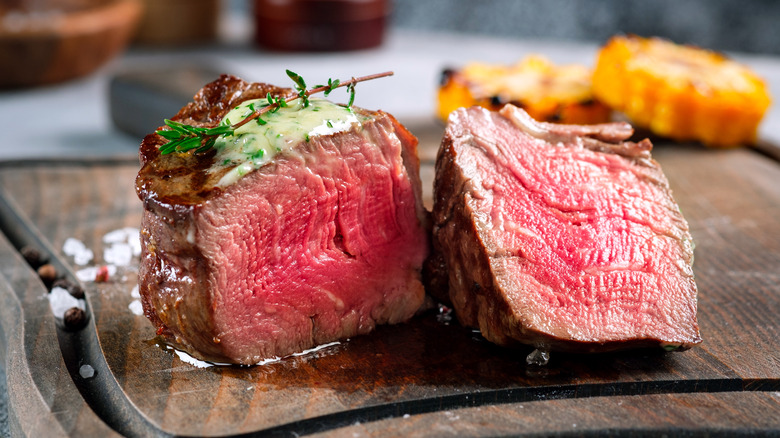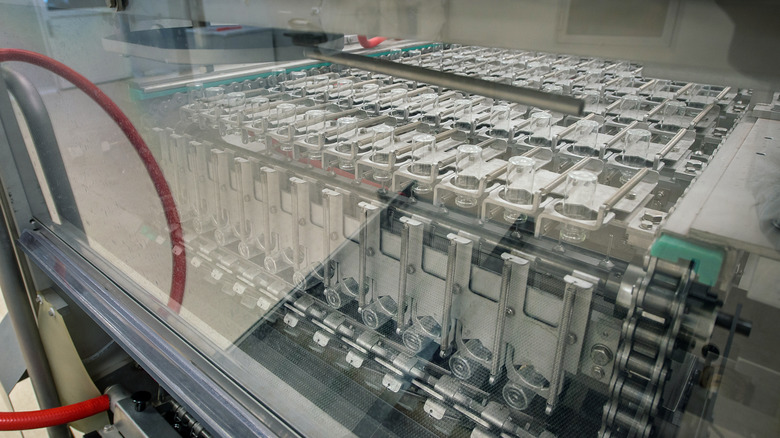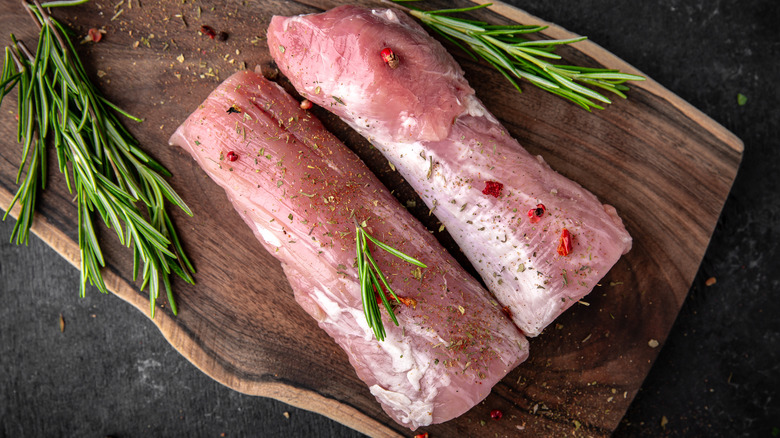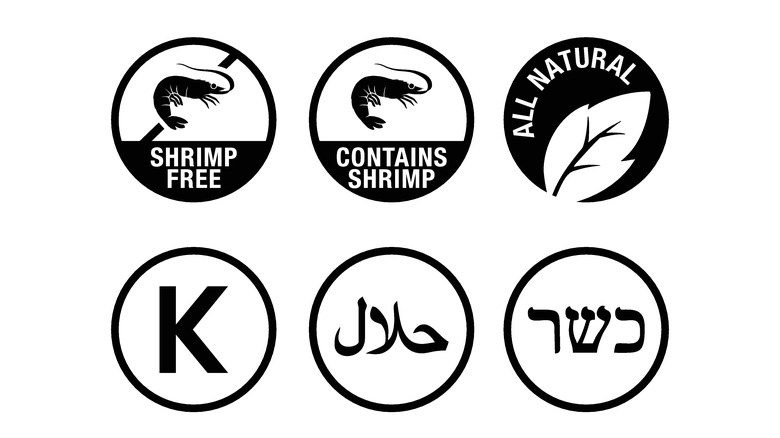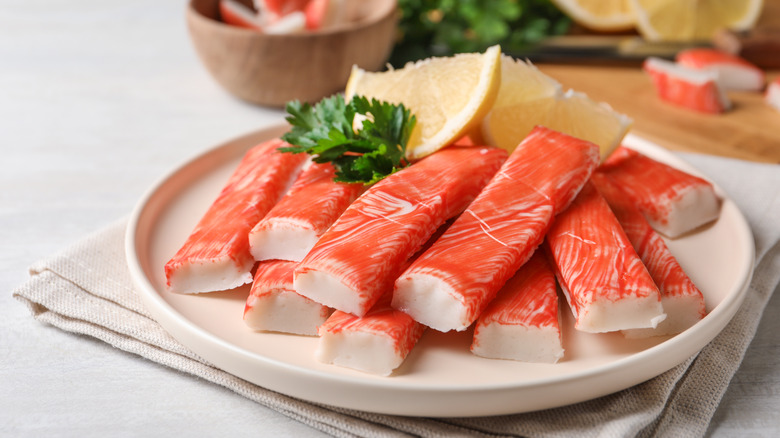What Is Meat Glue And Where Can You Find It?
"Meat glue" is the moniker given to a commonly utilized product called transglutaminase, per Penn State. At its most basic, transglutaminase is a food additive designed to bind ingredients together. It gets its name because it can be used to take scraps of meat from different cuts and essentially glue them together into one solid mass in a process known as "reassembling" or "reforming." Although it is most commonly found in meat, it has also been a staple in food manufacturing across the spectrum from dairy to seafood to baked goods for decades, according to Syracuse.com.
While there is some concern over lesser-quality cuts of meat being bound together and sold as a filet mignon or a pork tenderloin, this is a practice that is against the law and strictly regulated by the USDA. Still, there is much skepticism as to how meat glue is produced, how it is implemented, and how consistently it is properly labeled on food items. There are also ethical and health concerns associated with its widespread use. Manufacturers of the product, as well as the companies that regularly use it in their food production, insist that it is both safe and doesn't adversely impact the flavor of the food items to which it is added. We decided to take a closer look into what exactly goes into meat glue and how it can impact consumers.
How is meat glue made?
According to Healthline, transglutaminase is a protein that naturally occurs within the bodies of many living creatures. In humans, it is involved in a number of operations, including both sperm production and blood clotting. The transglutaminase utilized in food manufacturing comes in the form of a white powder and is manufactured under two labels, Activa and Fibrimex (via Penn State). Activa is produced by fermenting a bacteria called Streptoverticillium mobaraense. Fibrimex is isolated from the blood plasma of beef or pork and is made up of the components Fibrinogen and Thrombin, per Ingredient Supply Corporation.
Regardless of which brand is utilized, once the protein enzyme has been isolated, the process by which it actually binds two disparate food items together is fairly simple, according to McGill. Proteins are made up of complex chains of amino acids, and, when implemented, meat glue enables the lysine from one food's amino acid chains to adhere to the glutamine present in the chains of amino acids contained in another food. The end result creates a seamless structure with speckles of white resembling fat molecules.
What foods contain meat glue?
You may be surprised to know how pervasive the use of meat glue is in food manufacturing. Many of the most popular items sold in the grocery store are in fact produced utilizing the unique effect that this enzyme is capable of. It has been found in baked goods, cheese, tofu, sausages, fish, chicken nuggets, and dairy desserts (via Cook's Illustrated).
Reader's Digest suggests that of the meat consumed in the U.S. annually, approximately 8 million pounds may contain transglutaminase. You'll often find it in pork tenderloin, which naturally has an odd shape, making it inconsistent and challenging to portion out. By joining numerous tenderloins together, a caterer or restaurateur could obtain a product that would be uniform, making it easier to cook and serve.
Then there's the molecular gastronomy aspect to this conversation, which involves the creative expression of chefs are capable of using various food-safe chemicals in their endeavor to develop innovative recipes, per McGill. A case in point would be celebrated Chef Wylie Dufresne, who famously used meat glue to create a noodle out of ground-up shrimp. The result was an instant hit, potentially destigmatizing the use of this product in some circles.
Is meat glue safe to eat?
In terms of transglutaminase itself, meat glue is classified by the FDA as "generally recognized as safe" (GRAS) (via Healthline). However, there is an important caveat to this, particularly where meat is concerned. While the USDA discourages consuming rare meat, it is generally considered safe to consume a steak or roast rare if it comes from the same cut of meat. This is because most of the bacteria is concentrated on the exterior of the meat and seldom reaches the center — at least not in great enough quantities to make you ill.
This is not the case with meat that has been treated with meat glue. Because disparate cuts of meat are being bound together, bacteria can permeate throughout the entire piece, making it potentially hazardous to consume unless it is cooked to the proper internal temperature. Additionally, if a foodborne illness does occur, there is no way for investigators to determine the source of the outbreak. For many, that means eating a filet mignon that is well-done, which may not be a desirable choice. Nevertheless, this is the primary reason that the process of gluing meat together was outlawed by the European Union in 2010, although the use of transglutaminase in other contexts is still legal and considered perfectly safe, per Food Navigator.
Is meat glue gluten-free?
The subject of whether or not meat glue is gluten-free is complicated. While the word "transglutaminase" sounds like it contains gluten, the product itself does not, per Verywell Fit. The transglutaminase called meat glue is not identical to what occurs naturally in the human digestive system. Naturally occurring transglutaminase does cause an autoimmune response in those with celiac disease, resulting in the body creating antibodies that harm the intestinal linings, but it's unlikely that meat glue would adversely affect someone with a gluten intolerance or allergy. However, some transglutaminase products manufactured by Ajinomoto — the company responsible for the Activa brand of meat glue — may contain both maltodextrin and sodium caseinate obtained from dairy products. Both of these ingredients can cause an increase in symptoms associated with gluten intolerances.
The Gluten Free Society adds that there has been research conducted linking the consumption of transglutaminase with the increased permeability of the gastrointestinal tract known as "leaky gut." This may cause bacteria and toxins to be absorbed into the bloodstream, thereby triggering an immune response similar to celiac disease. And because of transglutaminase's unique ability to bind ingredients together, it is rampant in items produced specifically for those needing a gluten-free diet.
All of this creates a conundrum for those with gluten intolerances. Do they believe the manufacturers and researchers, or consumers who have experienced adverse reactions? Ultimately, it is recommended that if you have a gluten intolerance, you should avoid consuming products containing transglutaminase out of an abundance of caution until further research can be conducted (via Verywell Fit).
How do I know if a particular food has meat glue in it?
According to the USDA, any meat, poultry, or egg product containing transglutaminase must be labeled as such. Additionally, meat that has been produced using transglutaminase must use the word "formed" on the label. However, as Reader's Digest points out, labeling is often annotated to read "TG enzyme," "enzyme," or "TGP enzyme," making it potentially confusing.
What about other foods that are produced utilizing transglutaminase that fall under the jurisdiction of the FDA for regulation and labeling? According to a letter made public by the FDA, the Federal Food, Drug, and Cosmetic Act requires all food items be labeled if they contain a "major food allergen." These allergens include: milk, eggs, fish, crustacean shellfish, tree nuts, peanuts, wheat, soybeans, and sesame. Since transglutaminase obtained by isolating the protein from the bacteria Streptoverticillium mobaraense (commonly known as Activa) may contain protein from milk, it must be labeled accordingly.
This brings us to the question of which form of meat glue is used by a particular manufacturer — Activa or Fibrimex. While Fibrimex is recommended for use primarily in meat (via Ingredient Supply Corporation), meat glue sees use in baked goods as well, begging the question of whether or not the presence of Fibrimex would be indicated on a baked item's label since it doesn't fall under the same potential allergen criterion as Activa. With this in mind, if it isn't clearly indicated on a product's label and you are concerned about it, contact the manufacturer directly to inquire if the product contains transglutaminase.
Ethical concerns over meat glue
There is a serious ethical conundrum associated with the use of meat glue. For those observing dietary restrictions associated with their religious practices — namely those of Jewish or Muslim faith — which meat glue is used is of the utmost importance. Per Healthline, both those who observe kosher diets and those who observe halal diets have strict requirements regarding the ways in which an animal is slaughtered — one of which involves the removal of all blood before consumption. Additionally, pork is strictly forbidden in both faiths.
With this in mind, meat glue obtained through the fermentation of the Streptoverticillium mobaraense bacteria (namely Activa) would be acceptable, but meat glue obtained through the isolation of blood from cows or pigs would not (namely Fibrimex). Indeed, Activa is actually certified as kosher. Unfortunately, unless otherwise specified, there is no way to determine strictly by the label of a particular food item which brand was used. Therefore, it is advisable that those maintaining a strict kosher or halal diet refrain from consuming any foods produced using meat glue or transglutaminase in them.
What is the best way to avoid meat glue?
Ultimately, the best way to avoid eating meat glue is to opt for foods that are minimally processed. Look for meat that has been raised locally and humanely. Buying straight from the farm or the butcher can help you avoid "formed meat." And when eating out, opt for restaurants that are slightly higher end, where you can ask the chef or restaurant owner questions about where they source their meat from.
Speaking of restaurants, you may want to refrain from dining at establishments specializing in molecular gastronomy if the notion of consuming chemical additives in your food concerns you. While you likely won't experience any kind of adverse reaction or long-term health impact from one meal out, it is something to be aware of. These chefs have developed a craft where they use science to make foods do things that they aren't supposed to be able to do, and this necessarily involves the implementation of some unusual ingredients, like meat glue.
And finally, where other non-meat food items are concerned, reading food labels is key. If you aren't sure, either skip it or ask questions. It's always better to be safe than sorry.
